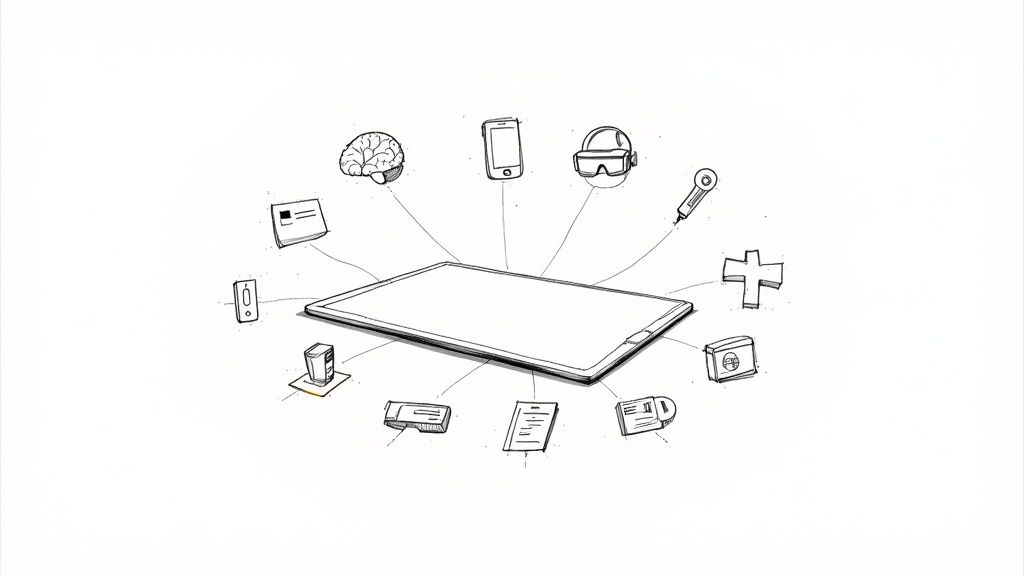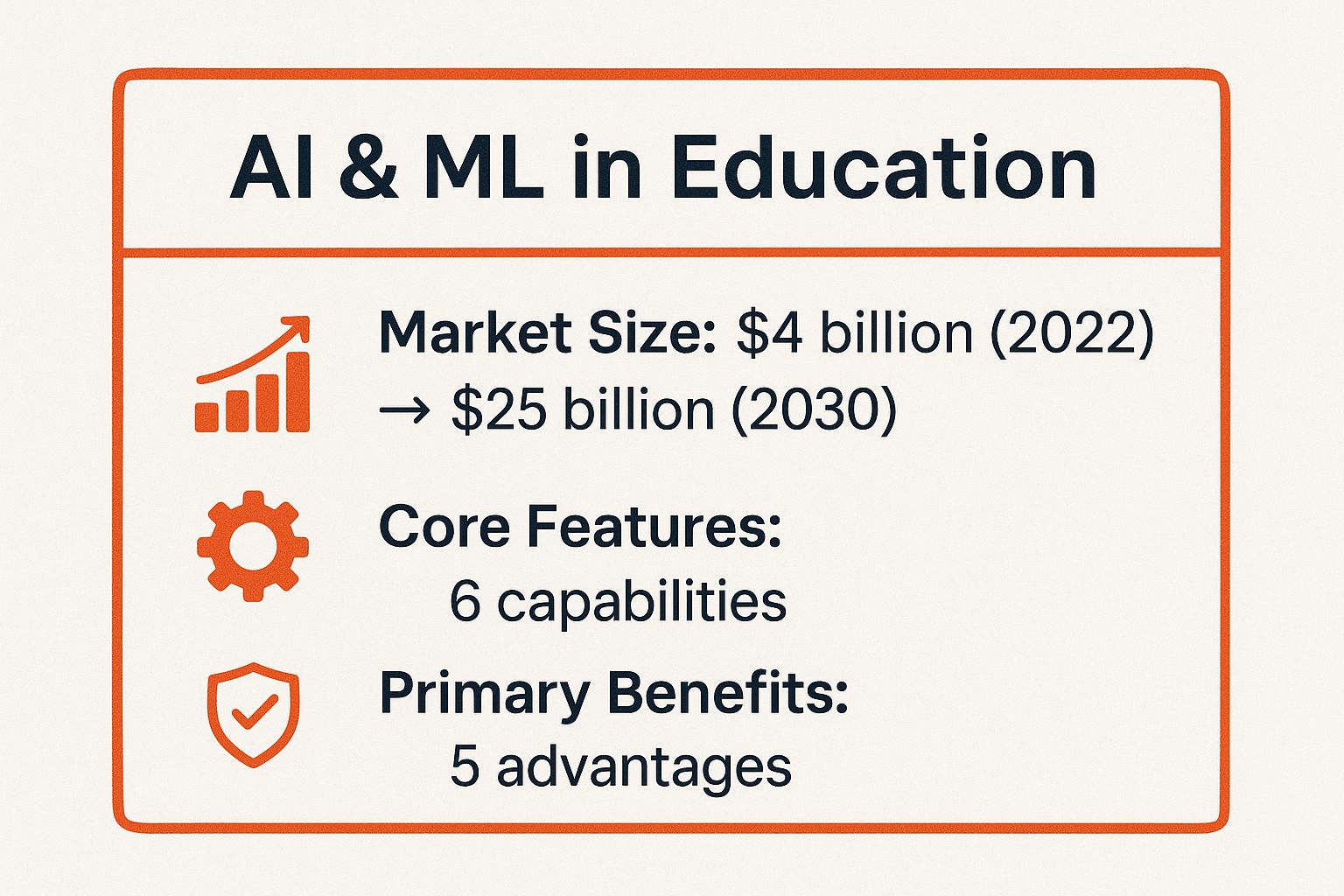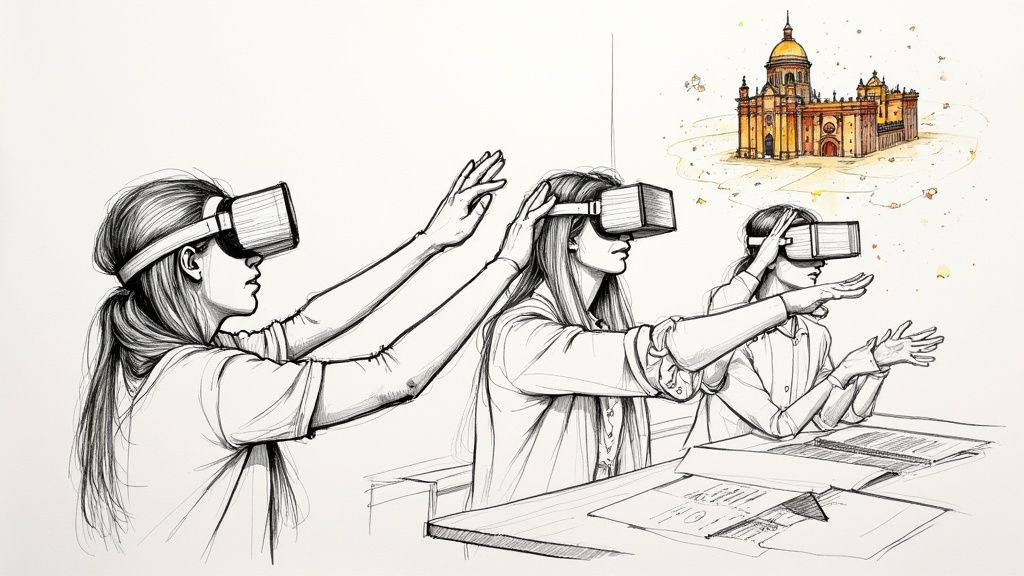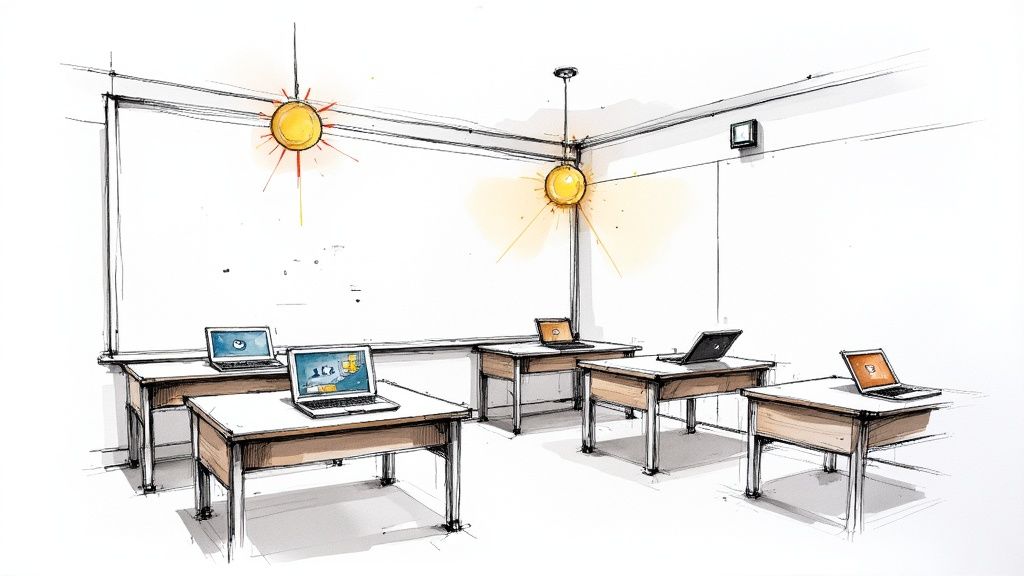
The world of education is transforming at lightning speed, and technology is firmly in the driver's seat. It's no longer just about digitizing textbooks; we're talking about a fundamental shift in how we design and deliver learning experiences. For instructional designers, corporate trainers, and educators, staying ahead of these changes isn't just an advantage, it's essential for survival and growth.
This article cuts straight to the chase. We're diving into the top 10 tech trends in education that are blending cutting-edge software with proven learning theory. We'll explore how tools like Artificial Intelligence, integrated Learning Management Systems (LMS), and authoring software like the Articulate Suite and Adobe Captivate are helping create more personalized, engaging, and effective learning journeys.
You won't find vague theories here. Instead, we'll provide actionable insights and practical examples for each trend, from AI-powered adaptive learning paths to the use of AR/VR for immersive simulations. Whether you're building corporate eLearning, pivoting your career into instructional design, or simply looking to innovate in the classroom, understanding these trends will equip you to craft content that truly connects and delivers measurable results. Let's get started.
Artificial intelligence (AI) and machine learning (ML) are no longer futuristic concepts; they are actively reshaping instructional design. This trend involves using smart algorithms to create more adaptive, efficient, and personalized learning journeys. Instead of a one-size-fits-all curriculum, AI tools can analyze a learner's performance in real time and adjust the difficulty, pace, and type of content they receive, a core principle of adaptive learning theory.
Think of it as a personal tutor for every learner. For instructional designers, AI can automate content creation, generate quiz questions, and even provide real-time feedback within eLearning modules created in tools like the Articulate Suite or Adobe Captivate. This frees up designers to focus on higher-level strategy and creative problem-solving. This is one of the most impactful tech trends in education because it directly addresses individual learner needs at scale.
For a quick overview, this infographic summarizes the market size, core features, and primary benefits of AI in education.

The rapid market growth shown here highlights how AI-driven platforms are becoming integral to modern learning ecosystems.
Getting started with AI doesn't have to be a massive overhaul.
Virtual reality (VR) and augmented reality (AR) are transforming learning from a passive to an active experience. These immersive technologies create digital environments where learners can practice complex procedures without risk, explore hazardous environments safely, and visualize abstract concepts in 3D. Instead of just reading a safety manual, an employee can virtually perform a complex repair on a machine, making learning unforgettable.
This hands-on approach is what makes immersive learning one of the most exciting tech trends in education. It bridges the gap between theoretical knowledge and practical application, a concept known as experiential learning theory. For instructional designers, tools are emerging that allow the creation of AR and VR scenarios directly within platforms like Adobe Captivate, making this technology more accessible than ever for corporate training.

This video demonstrates how VR is creating powerful new opportunities for experiential learning.
Integrating immersive tech can feel daunting, but a strategic approach makes it manageable.
Gamification turns learning into an engaging quest by applying game-design elements like points, badges, and leaderboards to educational content. This approach taps into our natural desire for achievement and competition, making the learning process more motivating and memorable. This is rooted in behavioral and motivational theories, where positive reinforcement drives engagement and knowledge retention.
This isn't just about playing games; it's about making learning feel like a game. Platforms like Kahoot! transform classroom quizzes into exciting competitions, while Classcraft turns classroom management into a collaborative role-playing adventure. This is one of the most engaging tech trends in education because it effectively harnesses motivation to drive learning outcomes, turning passive learners into active participants.

Instructional designers can integrate these elements directly into Articulate Storyline or Adobe Captivate courses to make even compliance training feel more dynamic.
Bringing game mechanics into your curriculum can transform student engagement.
Cloud computing and SaaS have become the backbone of modern educational infrastructure, shifting resources from local servers to the web. This trend provides scalable, accessible, and cost-effective solutions for everything from content delivery to administrative tasks. Instead of installing software on individual computers, organizations can now provide universal access to powerful tools through a web browser.
This has revolutionized corporate training and education. Cloud-based Learning Management Systems (LMS) like Canvas and Schoology centralize course materials, assignments, and communication. More recently, Learning Experience Platforms (LXP) like Degreed and EdCast have emerged, offering a more user-driven, Netflix-style approach to discovering content. This is one of the most foundational tech trends in education because it enables anywhere, anytime learning and collaboration.
The move to the cloud empowers institutions to provide reliable access to digital learning tools without the high cost and maintenance of on-premise hardware.
Adopting cloud services can transform your institution's efficiency and accessibility.
Learning analytics and big data are transforming education from an art into a science. This trend involves collecting, analyzing, and reporting data about learners and their contexts to understand and optimize learning. Instead of relying solely on intuition, instructional designers can now use data to see what’s working, who is struggling, and where interventions are needed most.
Think of it as a diagnostic tool for your entire learning ecosystem. A modern LMS or LXP provides rich analytics dashboards that track everything from course completion rates to time spent on specific modules. This data helps designers identify confusing content, pinpoint effective learning activities, and prove the ROI of their training programs. As one of the most powerful tech trends in education, data analytics provides the evidence needed to make informed, impactful instructional decisions.
This data-driven approach moves beyond simple grade books to create a holistic picture of the learning journey. By understanding patterns and behaviors, institutions can refine curriculum design and offer targeted support at scale.
Diving into data doesn't require a degree in statistics. You can start making an impact with a focused approach.
Mobile learning, or mLearning, leverages smartphones and tablets to deliver education on the go. This trend is perfectly paired with microlearning, an instructional design theory that breaks down complex topics into bite-sized, focused chunks (e.g., a 3-minute video, a short quiz, an infographic). Instead of long, formal sessions, learners can engage with content whenever they have a spare moment.
Think of it as learning that fits perfectly into the pockets of a busy schedule. This approach respects the learner's time and aligns with modern attention spans. It's one of the most practical tech trends in education because it meets learners where they are, transforming downtime into productive learning opportunities. It's particularly effective for performance support and just-in-time training.
Adopting a mobile-first strategy is more about design philosophy than just technology.
While often associated with cryptocurrency, blockchain technology offers a revolutionary approach to handling academic credentials. This trend uses a decentralized, secure digital ledger to issue, store, and verify educational achievements like degrees, certificates, and badges. Instead of relying on a central institution to validate a diploma, blockchain creates an immutable, tamper-proof record that learners own and control for life.
Think of it as a permanent, portable digital portfolio that can’t be faked. Institutions like MIT have pioneered issuing digital diplomas on the blockchain, allowing graduates to share verifiable credentials with employers instantly. Similarly, platforms built on the Blockcerts open standard enable schools to issue secure digital records that are easily verified. This is one of the more forward-thinking tech trends in education because it addresses the long-standing challenges of credential fraud and cumbersome verification processes.
The primary benefit is empowering learners with true ownership of their academic history, making it simple to prove their qualifications across jobs and further education.
Integrating blockchain may seem complex, but you can start with a focused approach.
The Internet of Things (IoT) is transforming traditional classrooms into connected, intelligent learning environments. This trend involves embedding sensors and smart devices into the school's infrastructure to automate tasks, gather data, and create a safer, more efficient space. Instead of manual adjustments, IoT systems can automatically manage lighting, temperature, and even take attendance, creating an optimized setting for learning.
Imagine a classroom that adjusts its lighting based on natural light levels to reduce eye strain or a system that alerts staff to a security issue in real time. Solutions from companies like Cisco and Honeywell are making this a reality by connecting everything from smartboards to HVAC systems. This is one of the most practical tech trends in education because it uses data to improve the physical learning environment itself, directly impacting student well-being and focus.

The ability to create responsive and secure educational spaces is driving the adoption of IoT across campuses worldwide.
Integrating IoT is about building a smarter, safer campus one step at a time.
Adaptive learning technologies take personalization to the next level by creating truly dynamic educational experiences. This is a direct application of instructional design theory powered by AI. Instead of a linear curriculum, these systems use algorithms to adjust the content, pace, and difficulty in real time based on a student's performance. This ensures that learners are always challenged but never overwhelmed, helping them achieve mastery more efficiently.
Think of it as a smart learning pathway that re-routes itself based on your progress. Platforms like DreamBox Learning for math or McGraw-Hill's ALEKS use this approach to identify knowledge gaps and serve up the right content at the right time. This is one of the most powerful tech trends in education because it moves beyond a one-size-fits-all model and creates an optimal learning journey for every individual student.
Integrating adaptive technology requires a strategic approach to content and a focus on the learner's journey.
Learning doesn't happen in a vacuum; it’s often a social activity, a concept formalized by social learning theory. This trend leverages collaborative technologies and social media concepts to create community-driven educational experiences where learners engage with each other. Instead of passive content consumption, these platforms foster peer-to-peer learning, knowledge sharing, and group projects, making education more interactive and connected.
Think of it as creating a dedicated online campus community. Many modern LMS and LXP platforms now include social features like forums, user-generated content, and expert Q&A channels. Tools like Flipgrid allow students to share ideas through video discussions, while platforms like Padlet act as collaborative digital bulletin boards. This is one of the most engaging tech trends in education because it taps into the power of community to deepen understanding and build soft skills.
Building a thriving online learning community requires intentional design.
We've journeyed through a landscape buzzing with innovation, from the predictive power of AI to the immersive worlds of VR and the bite-sized efficiency of microlearning. The tech trends in education we explored aren't just isolated flashes of brilliance; they represent a fundamental shift in how we approach learning and development. The common thread connecting everything from Learning Experience Platforms (LXP) to adaptive technologies is a powerful move toward a more human-centered model: personalized, accessible, data-driven, and deeply engaging.
The sheer number of options can feel overwhelming. Do you need a blockchain for credentials, or would a robust LMS with better analytics suffice? The secret isn't to chase every new, shiny object. Instead, the goal is to build a strategic toolkit. True mastery in instructional design lies in understanding your learners' specific needs and your organization's core objectives, then selecting the right tool for the job.
So, where do you begin? Don't try to boil the ocean. True transformation starts with small, intentional steps.
Ultimately, embracing these tech trends in education is about more than just staying current. It's about empowering learners, creating more dynamic and effective training, and unlocking human potential. The future of learning isn't about replacing the human element with technology; it's about augmenting our ability to teach and connect in ways we never thought possible.
Ready to turn this knowledge into your next career move? Whether you're looking to build a team of top-tier learning professionals or land your dream role as an instructional designer, Relevant Training is your dedicated hub for the L&D industry. Explore our job board at Relevant Training to find curated opportunities and connect with companies shaping the future of education.